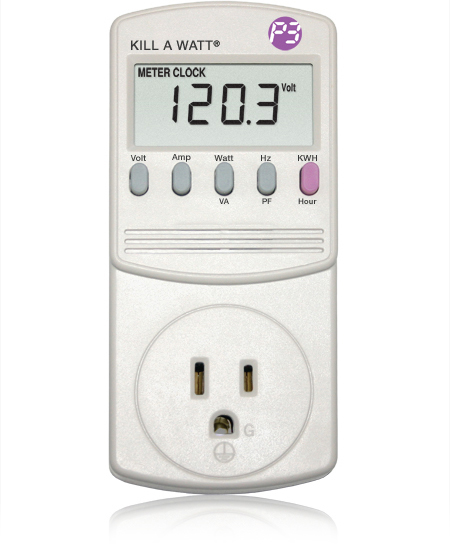I "won" one of these from my electric cooperative a few months back.
![Image]()
Kill-A-Watt Link

Kill-A-Watt Link
Since then I have been playing around with it, experimenting on what it costs to operate different appliances in my home. The "Kill-A-Watt" keeps track of total KWH's used by whatever is plugged into it, for as long as the appliance is plugged into it. It also monitors voltage, frequency, real time load in amps or watts, as well as volt/amps and power factor. I don't even know what a VA or PF mean. (someone please explain!)
Anyway... most recently I had the device hooked up to my Bunn coffee maker. As fellow Bunn owners know, the coffee maker is never turned off. It runs 24/7 keeping water hot for your next cup of coffee. It makes a full pot in about 3 minutes.
Here are my findings for energy usage for the Bunn for a month. I make at least 1 pot of coffee a day. We also use it from time to time to make hot water for cappuccino mixes, soups, etc. I tried to use it use it just as I would have in a "normal" month. Plug in your own cost's per KWH, and you should get a rough idea what you are using.
Total time of test= 731 hours (30.45 days)
Total KWH usage= 28.46 KWH
28.46 X .085/KWH= $2.42 for the month.
I expected a lot worse!
The Bunn has a small heater running all of the time. It uses 30 Watts 24/7 regardless if it is in use or not. When the water gets too cold, the big heater will cycle. That heater is about a 700 watt heater (seems to vary) and will come on when adding water or a few times a day to "catch up". Then there is the warming plate, 130 watts, that is seldom used in our house. Most of the time I make coffee, it is in the thermos bottle and out the door!
Currently I have the Kill-A-Watt hooked up to my Mac Mini computer and all of the peripherals (printer, speakers, monitor, etc.) The computer never gets shut off, though does go to "sleep" when not in use. I will let you know in another 25 days or so what I find!
Anyway... most recently I had the device hooked up to my Bunn coffee maker. As fellow Bunn owners know, the coffee maker is never turned off. It runs 24/7 keeping water hot for your next cup of coffee. It makes a full pot in about 3 minutes.
Here are my findings for energy usage for the Bunn for a month. I make at least 1 pot of coffee a day. We also use it from time to time to make hot water for cappuccino mixes, soups, etc. I tried to use it use it just as I would have in a "normal" month. Plug in your own cost's per KWH, and you should get a rough idea what you are using.
Total time of test= 731 hours (30.45 days)
Total KWH usage= 28.46 KWH
28.46 X .085/KWH= $2.42 for the month.
I expected a lot worse!
The Bunn has a small heater running all of the time. It uses 30 Watts 24/7 regardless if it is in use or not. When the water gets too cold, the big heater will cycle. That heater is about a 700 watt heater (seems to vary) and will come on when adding water or a few times a day to "catch up". Then there is the warming plate, 130 watts, that is seldom used in our house. Most of the time I make coffee, it is in the thermos bottle and out the door!
Currently I have the Kill-A-Watt hooked up to my Mac Mini computer and all of the peripherals (printer, speakers, monitor, etc.) The computer never gets shut off, though does go to "sleep" when not in use. I will let you know in another 25 days or so what I find!




